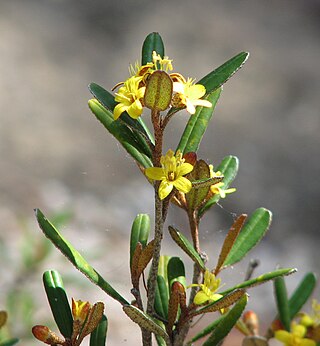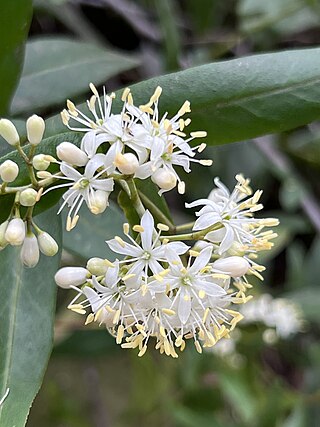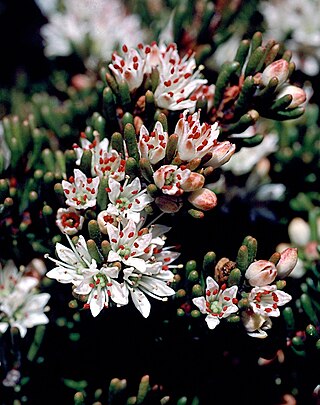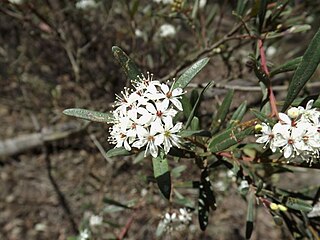
Phebalium whitei is a small shrub that is endemic to south-east Queensland. It has branchlets covered with silvery and rust-coloured scales, leathery, oblong to elliptic leaves and bright yellow flowers arranged in sessile umbels on the ends of branchlets.

Leionema ambiens is a rare shrub growing in the Guyra district of New South Wales and Queensland, Australia. It has long stem clasping leaves and heads of white flowers in spring and early summer.

Phebalium squamulosum , commonly known as scaly phebalium or forest phebalium, is a species of shrub or slender tree that is endemic to eastern Australia. It has smooth branches covered with rust-coloured scales, linear to elliptical or egg-shaped leaves with the narrower end towards the base, and pale to bright yellow flowers in umbels with rust-coloured or silvery scales on the back.

Leionema elatius, commonly known as tall phebalium, is a shrub species that is endemic to New South Wales and Queensland in Australia. It has glossy green, variably-shaped leaves and clusters of white-lemon flowers in spring.

Leionema phylicifolium, commonly known as alpine phebalium, is a shrub that is endemic to south-eastern Australia. It is a small shrub with green, smooth, leathery leaves and pale yellow flowers in spring.
Nematolepis frondosa, commonly known as leafy nematolepis, is a shrub that is endemic to Victoria, Australia. It is a small, conical shaped shrub with glossy leaves, scaly branchlets and white flowers in winter and spring.

Leionema dentatum, commonly known as toothed phebalium is a species of large shrub or small tree that is endemic to New South Wales, Australia. It has variable leaves, slender branches and clusters of cream-yellow flowers in spring.

Leionema diosmeum is a shrub species in the family Rutaceae that is endemic to southern New South Wales, Australia. It has an upright habit, stems with fine soft hairs, variable shaped leaves and yellow flowers from late winter to spring.

Leionema ellipticum is a shrub species that is endemic to Queensland in Australia. It is a small shrub with smooth green leaves and creamy-white flowers in spring.
Leionema equestre, commonly known as Kangaroo Island phebalium, is a shrub species that is endemic to South Australia. It is a small spreading shrub with rough, green leaves and whitish-pink flowers from late winter to October.
Leionema hillebrandii, commonly known as Mount Lofty phebalium, is a perennial, woody shrub endemic to South Australia. It has variable shaped leaves and pinkish flowers from late winter to spring.
Leionema lachnaeoides, is a tall shrub with aromatic leaves and yellow flowers from winter to late spring. It is restricted to the Blue Mountains in New South Wales.

Leionema microphyllum, commonly known as limestone phebalium, is a small shrub with terminal clusters of white-pink flowers in spring. It is a rare plant in Victoria and South Australia.

Leionema montanum, is a small shrub with terminal clusters of white-pink flowers in upper leaf axils in spring. It is endemic to Tasmania.

Leionema obtusifolium, is a small shrub with yellow-white flowers in terminal clusters at the end of branches. It is endemic to Queensland.

Leionema oldfieldii is a small shrub that is endemic to mountainous locations in Tasmania, Australia. It has dark green leaves, compact pale pink to white flowers from November to January.

Leionema ralstonii, is a small shrub with angular, smooth branchlets and pale green flowers in winter. It is restricted to the south coast of New South Wales.

Leionema rotundifolium, is a dense shrub with needle-shaped stems and pale lemon to white terminal flowers. It is found in New South Wales and Queensland.

Leionema viridiflorum commonly known as green phebalium, is a species of flowering plant in the family Rutaceae. It is a small shrub with pale yellow-greenish flowers in clusters at the end of branches from winter to early spring. It has a restricted distribution in northern New South Wales.

Nematolepis elliptica, is a small, bushy shrub with white flowers in small clusters from September to November. It is endemic to the south coast of New South Wales.
















